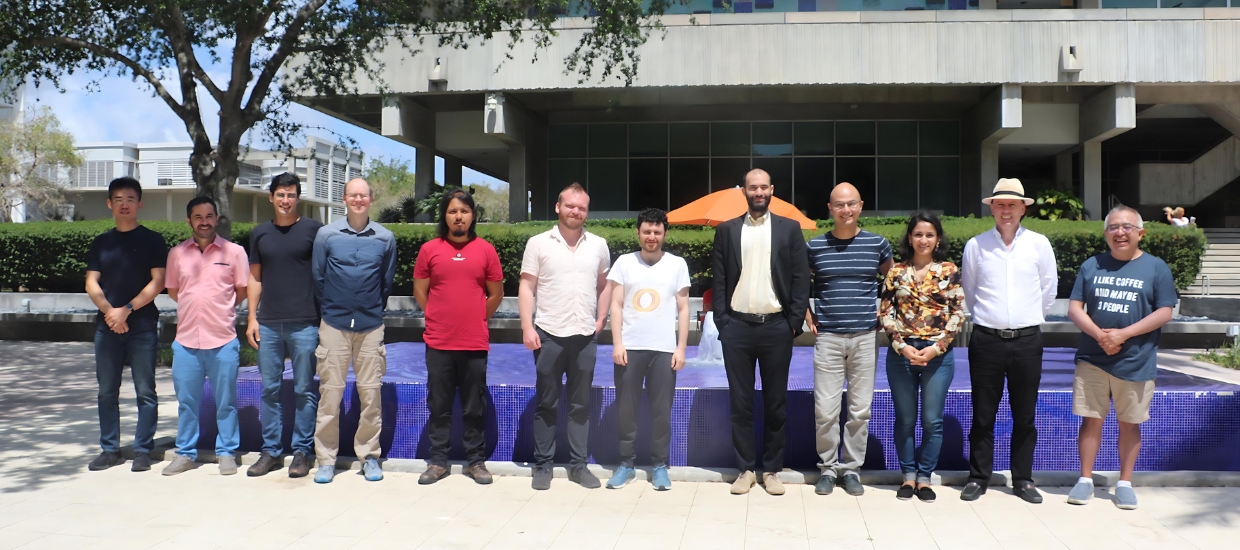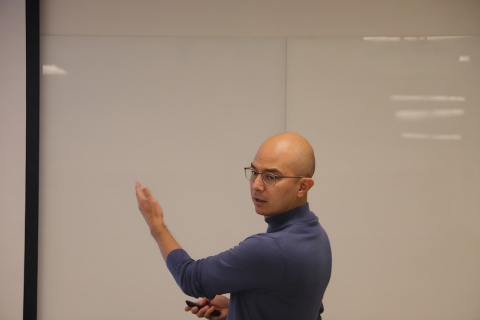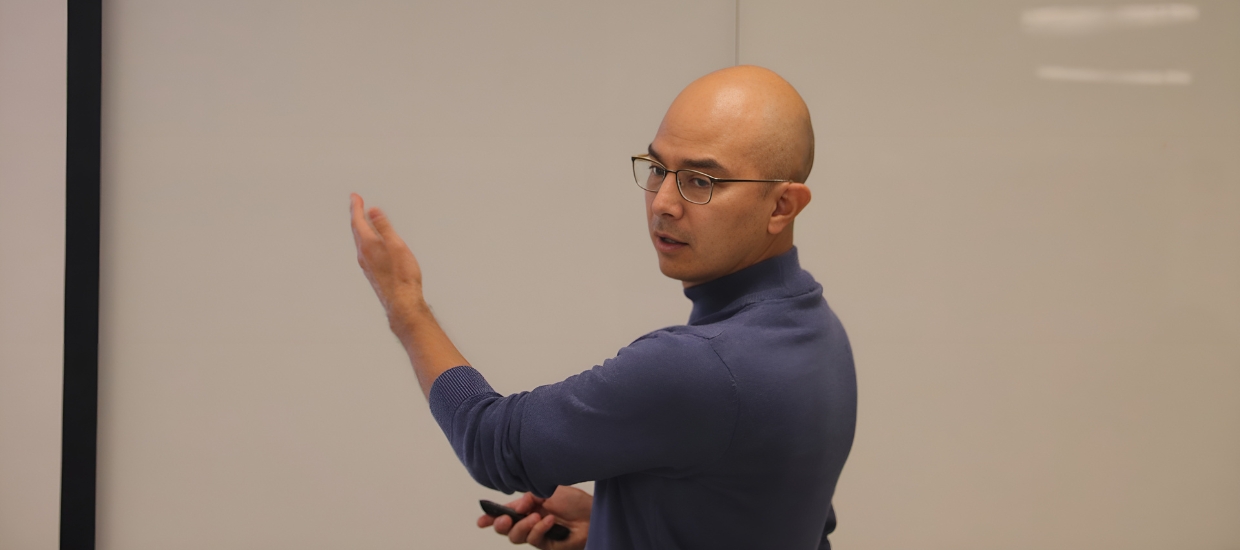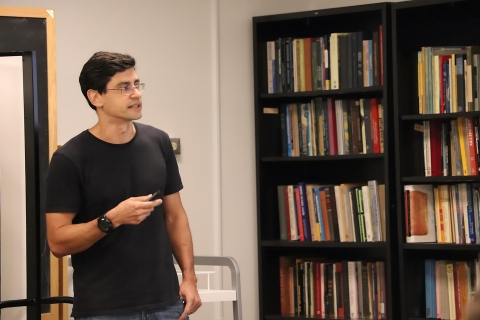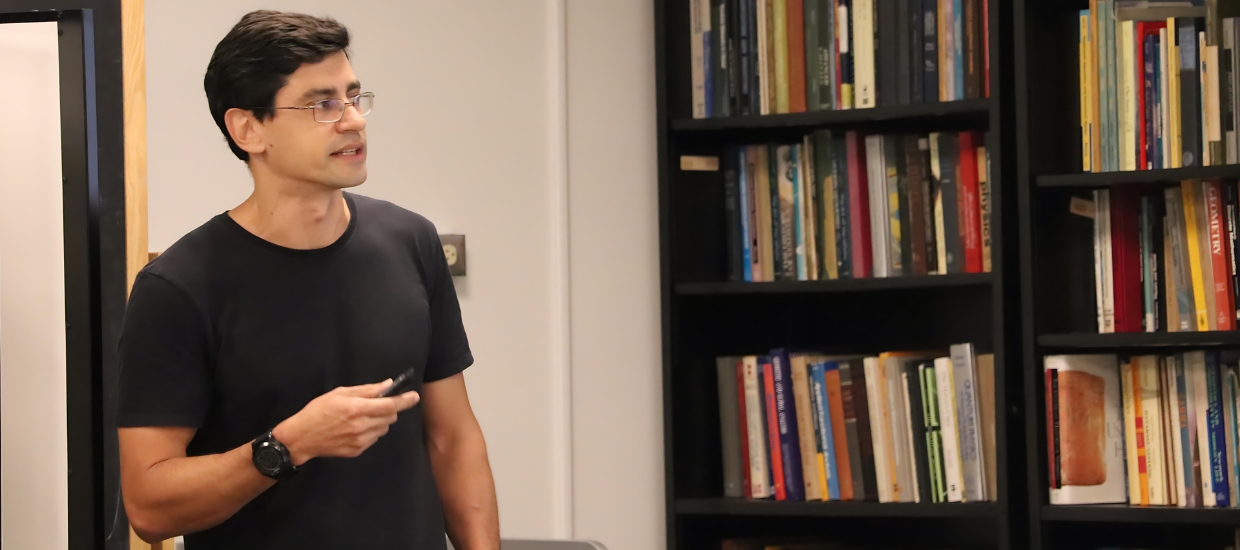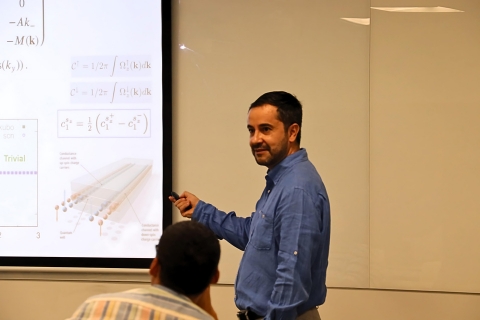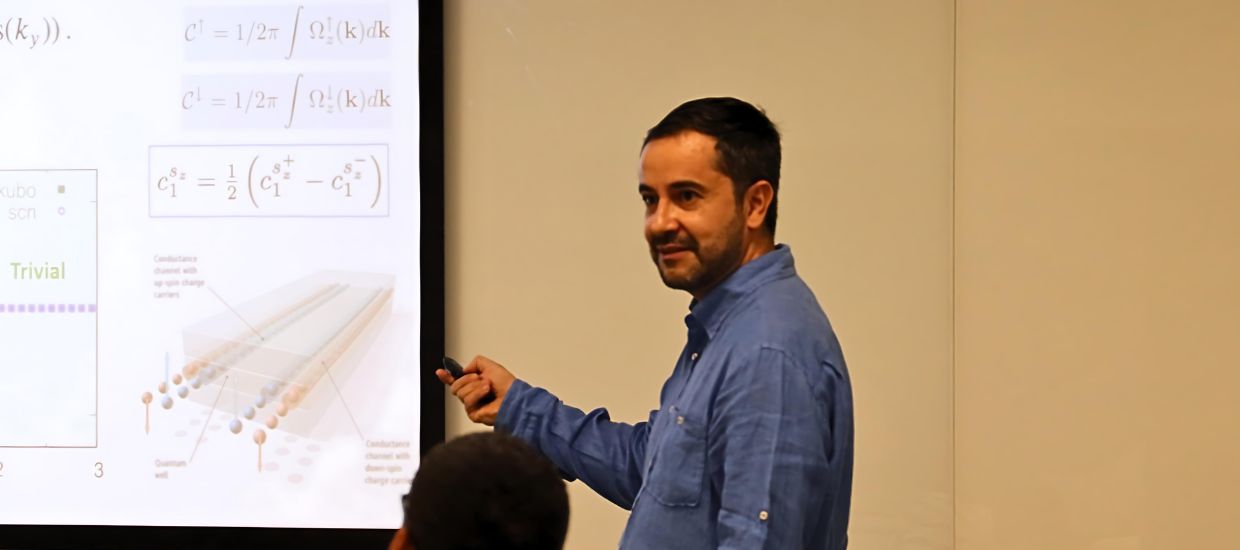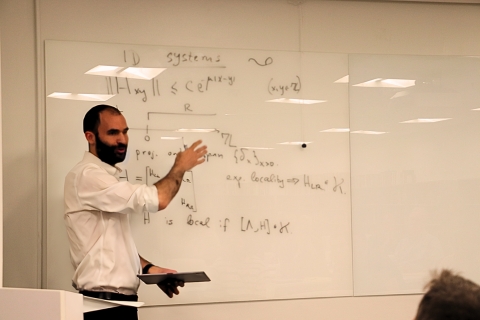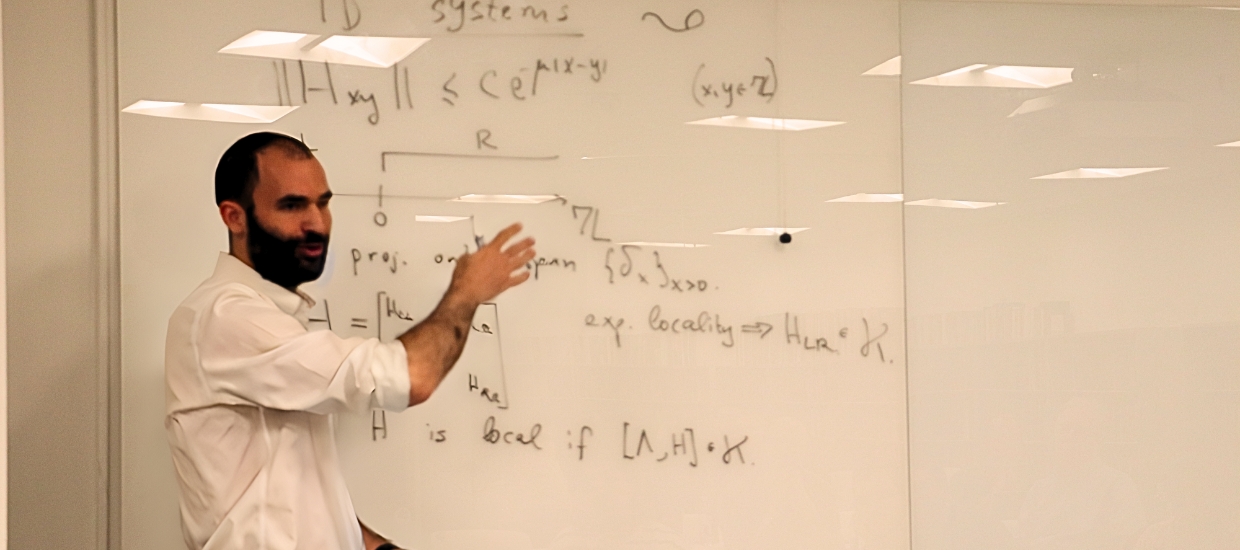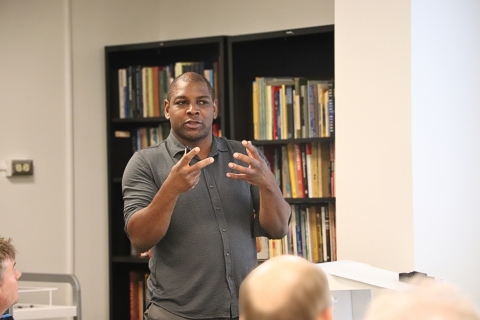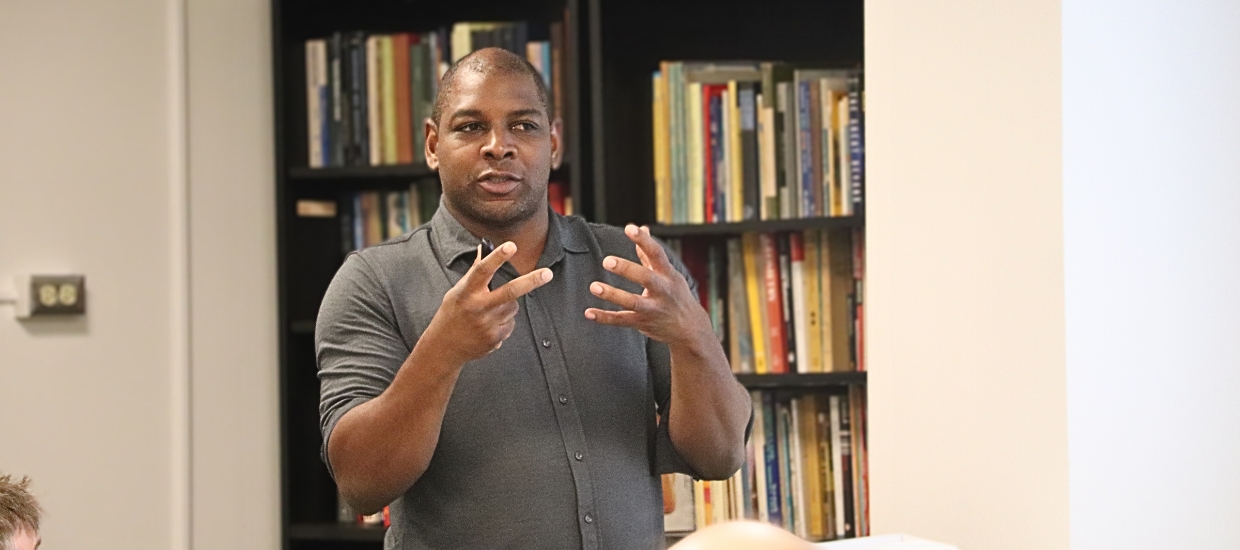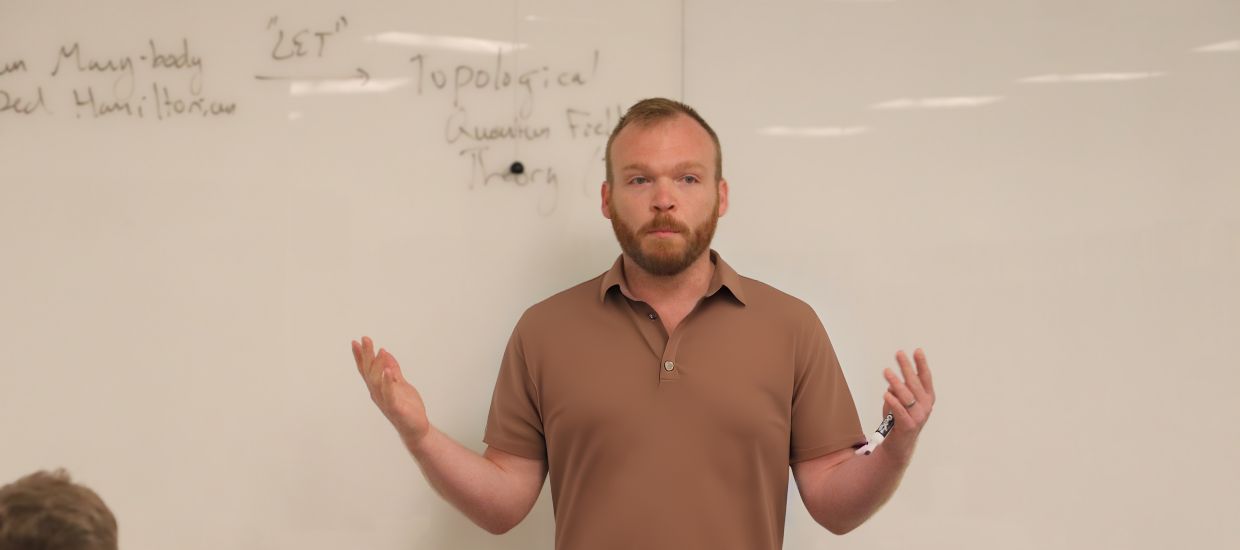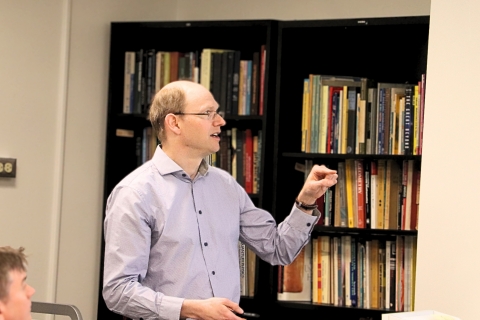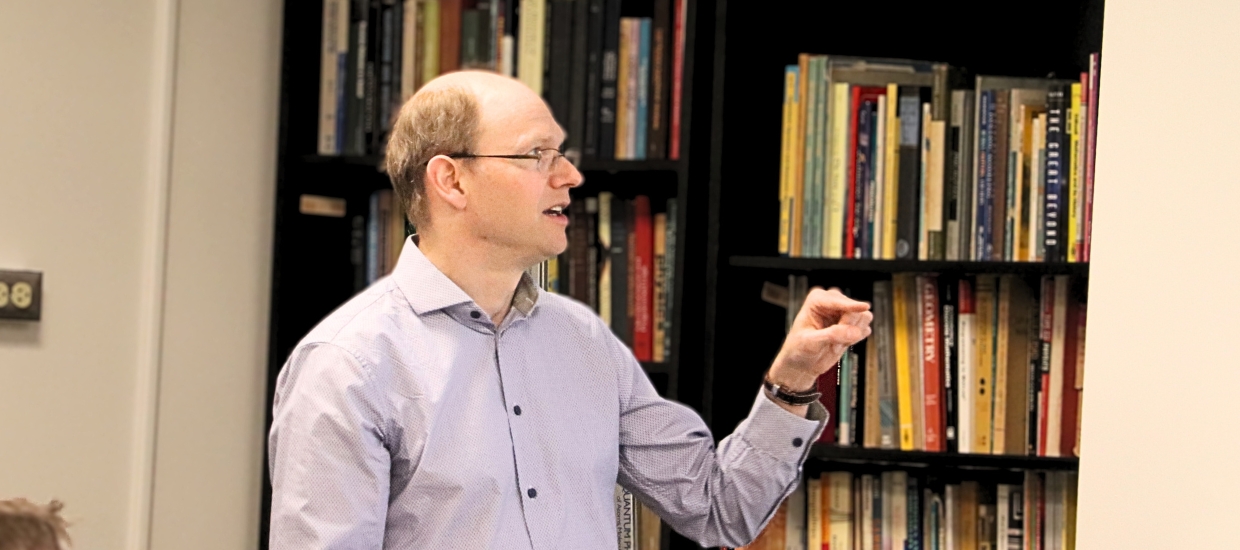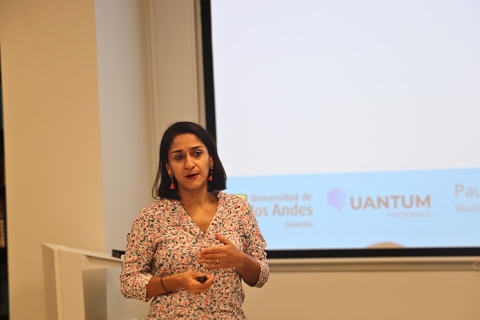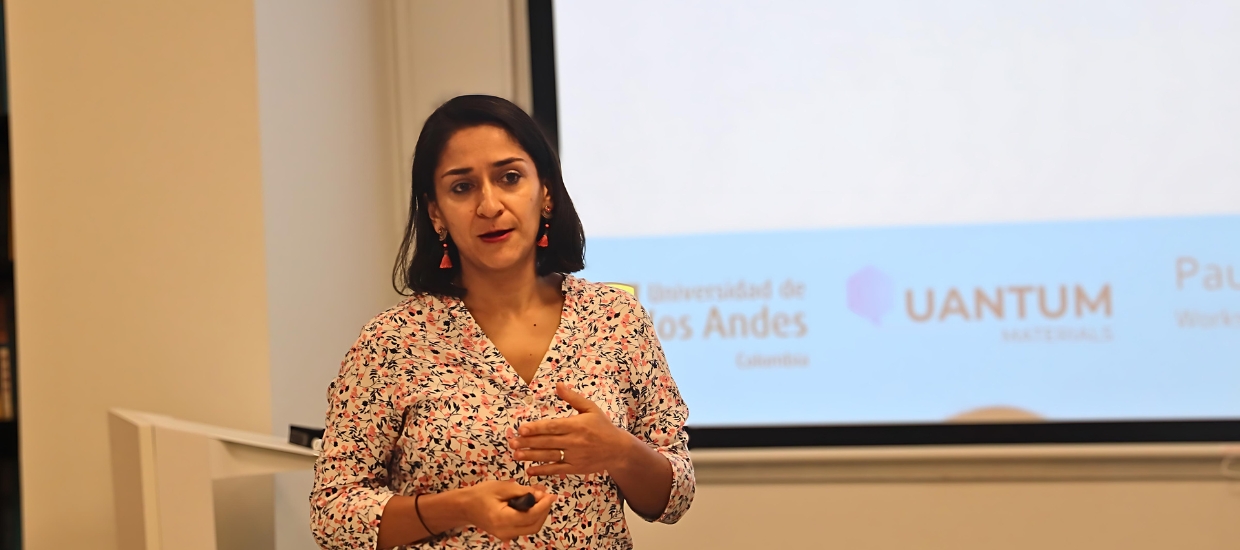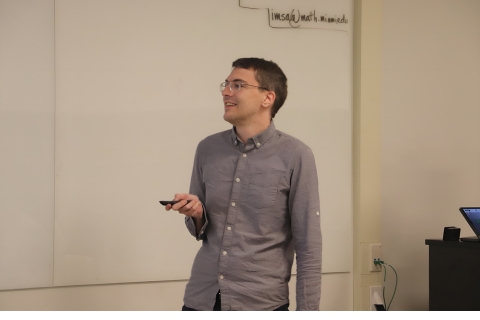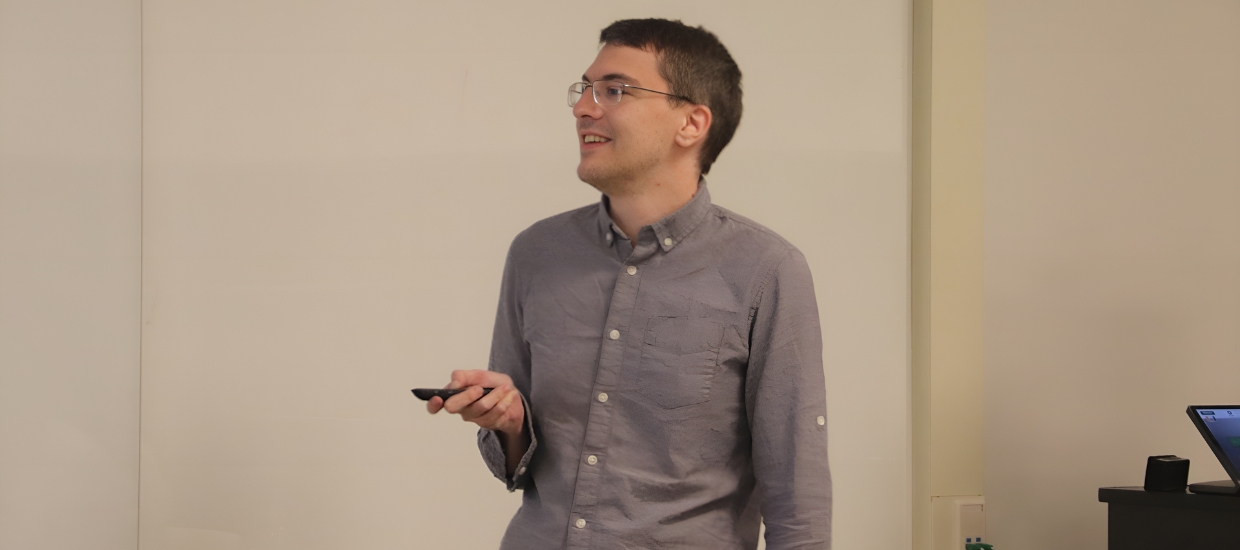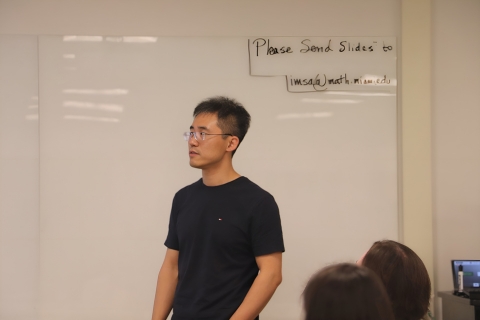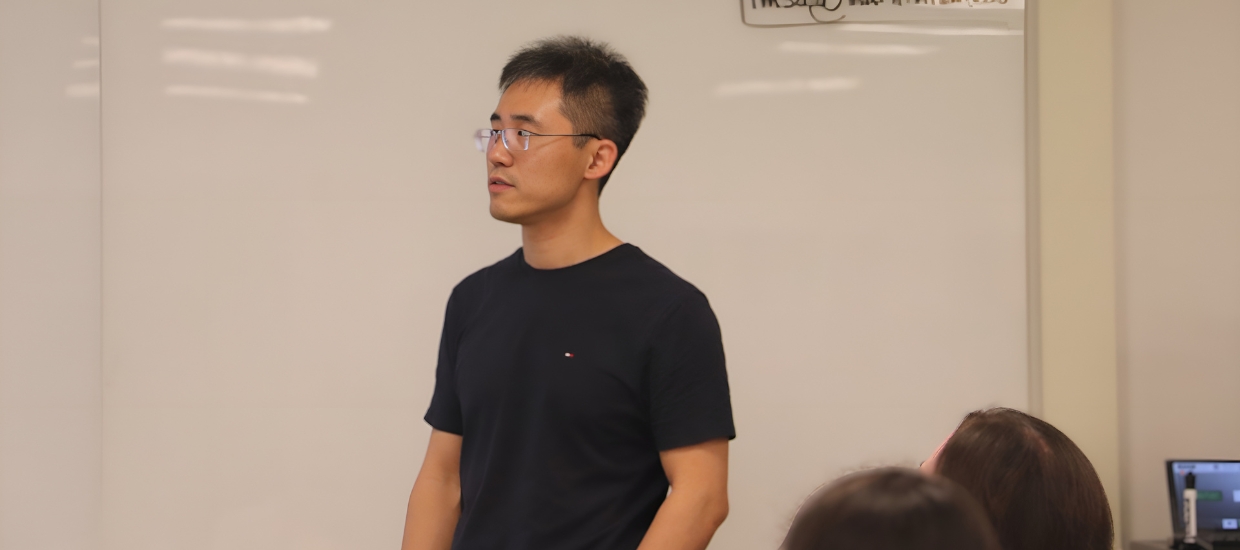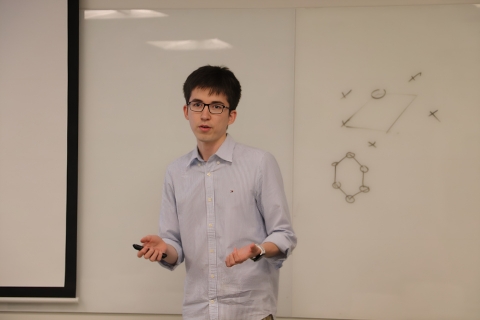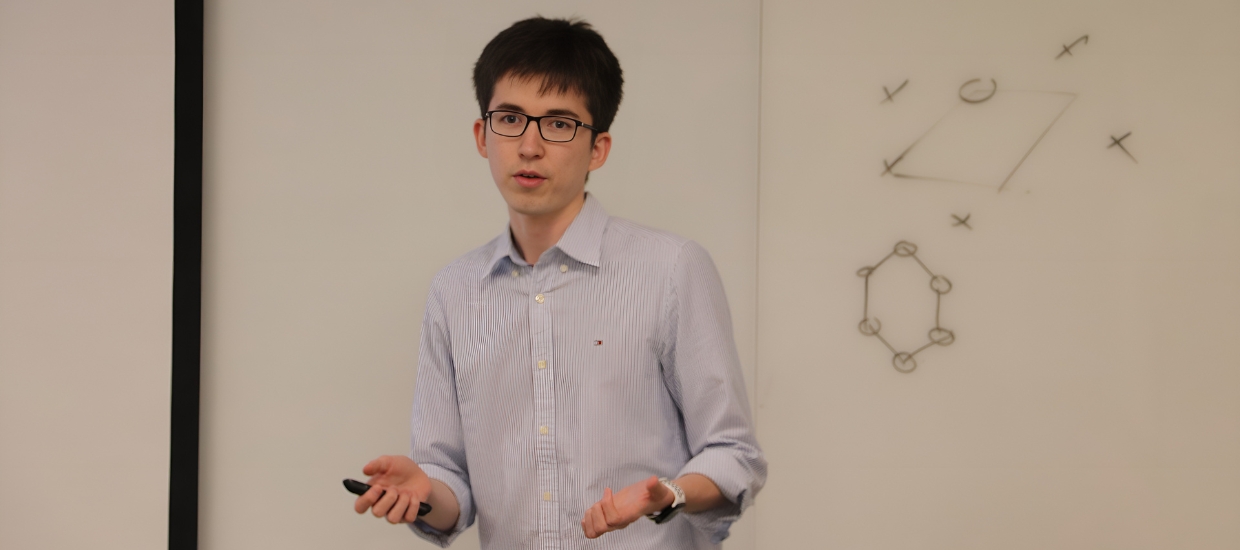Dates: April 15-18, 2024
Location: Ungar Bldg, Room 528-B, 1365 Memorial Dr, Coral Gables, FL 33146
Live Video Available via Zoom
To register, please click here.
Organizer: Bernardo Uribe, Rafael Gonzalez & E.Lupercio
For UM shuttle information, please click here.
Schedule
Monday, April 15, 2024
| 1:00pm |
Welcome
|
| 1:30pm |
Emil Prodan, Yeshiva University, USA: Topological gapped phases supported by a twisted bilayer
In the first part, I will use explicit examples of periodic mass-spring systems experiencing a periodic potential, with the lattice of this potential twisted. After sampling different lattices, I will point out that the phonon resonant spectrum display Hofstadter character when mapped against the twist angle. Furthermore, I will show that the dependence of the values of the integrated density of states inside the spectral gaps can be fitted with a single function of twist angle, regardless of the lattice or specific form of potential. To explain these findings, we demonstrate that any tight-binding Hamiltonian pertinent to such double layer system lands in the algebra known as the non-commutative 4-torus. The latter coincides with algebra of magnetic translations in 4-dimensions, with the fluxes determined by the twist angles and by the parameters of the two lattices. From this connection, we can enumerate all gapped topological phases supported by such lattice and point out new physical effects. For example, measuring the Hall conductance while periodically twisting the layers will map a non-linear transport coefficient that, up to a known constant, is quantized by the value of a 2-nd Chern number. Another example is the quantization of the spectral flow at the edges of a sample set in motion by the sliding of the two layers. Video
|
| 3:00pm |
Bernardo Uribe, Universidad del Norte, Colombia: Magnetic symmetries protecting the Chern-Simons axion coupling θ term
It has been argued in the literature that the non-triviality of the Chern-Simons axion coupling θ term can be protected by time reversal symmetry, inversion, or any combination of either one with a rotation or a translation. In this talk I will present Higinio Serrano's main result of his Phd thesis, where it is shown which rotations composed with time reversal symmetry protect the θ term and which rotations composed with time reversal do not. This talk is based on joint work with Miguel Xicotencatl and Higinio Serrano on the one side, and with Rafael Gonzalez on the other. Video
|
| 4:15pm |
Jedediah Pixley, Rutgers University, USA: The Phase diagram of disordered three-dimensional Z2 topological insulators
We consider how disorder impacts the phase diagram of three-dimensional (3D) topological insulators. We start by focusing on the critical point that separates Z2 topological and trivial insulator phases, which in 3D is characterized by a Dirac semimetal. We revisit the structure of the phase diagram of disordered topological insulators in 3D with a particular focus on the stability of the Dirac semimetal critical point by reviewing the effects of disorder on Dirac and Weyl semimetals and show how non-perturbative effects induce quasi-bound states that destabilize the semimetal for infinitesimal disorder strength. We apply these results to show that non-perturbative effects of disorder dominate in the vicinity of the topological to trivial transition, which we show turns this critical point into a diffusive metal phase, thus fundamentally altering the putative phase diagram of disordered Z2 topological insulators. Video
|
Tuesday, April 16, 2024
| 9:30am |
Nicolas Regnault, Ecole Normale Supérieure Paris, CNRS France, and Princeton University, USA: Moiré fractional phases of matter
In the realm of condensed matter physics, the fractional quantum Hall effect stands as a singular experimental manifestation of topological order, characterized by the presence of anyons—quasiparticles that bear fractional charge and exhibit exchange statistics diverging from conventional fermions and bosons. This phenomenon, observed over four decades ago, was still missing the direct observation of similar topological orders arising purely from band structure—without the application of strong magnetic fields. In 2023 within the span of a few months, several pioneering experiments have illuminated this once theoretical domain. Studies on twisted homobilayer MoTe2 and pentalayer rhombohedral graphene placed on hBN have finally unveiled the existence of fractional Chern insulators (FCIs), the zero-magnetic field analog of fractional quantum Hall states.
The journey to this point, preceded by over a decade of theoretical frameworks and predictions surrounding FCIs, yet the experimental revelations have proved to be richer and more surprising than expected. In this talk, we will present how the combination of ab-initio and quantum many-body calculations can help us capture the different features observed in experiments. We will discuss the potential future for this exciting booming field, including the possible observation of fractional topological insulators, a yet-never observed topological ordered phase preserving the time reversal symmetry. Video
|
| 10:45am |
Charles Kane, University of Pennsylvania, USA: Topology of the Fermi Sea
The Fermi sea in a metal is a topological object characterized by an integer topological invariant called the Euler characteristic, \chi_F. In this talk we will argue that \chi_F is reflected in quantized non-linear response and correlation functions. For a D dimensional Fermi gas, the D+1’th order density correlation function is quantized and reflects \chi_F. \chi_F also shows up in non-linear response functions. We will critically address the role of electron interactions, and we will propose experiments on cold atomic gas systems as well as 2 dimensional electronic materials. We will go on to show that for a D dimensional Fermi gas, \chi_F is also reflected in the multipartite entanglement characterizing D+1 regions that meet at a point. This generalizes a well-known result that relates the bipartite entanglement entropy of a 1+1D conformal field theory to its central charge c. We will argue that for an interacting 3D Fermi liquid, \chi_F distinguishes distinct topological Fermi liquid phases. Video
|
| 11:45pm |
LUNCH
|
| 1:30pm |
Rafael Gonzalez Hernandez, Universidad del Norte, Colombia: Spin Topology in Insulating Materials
In this joint work with Bernardo Uribe, we study the role of electron spin in establishing topological invariants in insulating materials. We explore how the spin valence operator, induced by the spin operator, provides crucial information about spin Chern class phases. Gapped spin valence spectra denote constant spin Chern numbers, defining materials as spin Chern insulators. Conversely, changes in spin Chern numbers occur at zero spin spectrum values, characterizing materials as spin Weyl topological insulators. We also introduce the average spin Chern number to classify non-trivial spin transport properties in 3D topological insulators, which closely correlates with the spin Hall conductivity within the bandgap. Video
|
| 3:00pm |
Jacob Shapiro, Princeton, USA: Classification of disordered insulators in 1D
In this talk I will describe some of the mathematical aspects of disordered topological insulators. These are novel materials which insulate in their bulk but (may) conduct along their edge; the quintessential example is that of the integer quantum Hall effect. What characterizes these materials is the existence of a topological index, experimentally measurable and macroscopically quantized. Mathematically this is explained by applying algebraic topology to the space of appropriate quantum mechanical Hamiltonians; I will survey some recent results mainly concentrating on the classification problem in one dimension, where the problem reduces to studying spaces of unitaries (resp. orthogonal projections) which essentially-commute with a fixed projection. Joint with Jui-Hui Chung. Video
|
| 4:15pm |
Jacob Gayles, University of South Florida, USA: “Disorder” in Multi-Band topological Semimetals
Topological magnetic semimetals, like Co3Sn2S2 and Co2MnGa, display exotic transport properties, such as large intrinsic anomalous (AHE) due to uncompensated Berry curvature. These materials show simple topological crossings of two bands in the electronic structure, where the transport responses should show some degree of protection due to the inherent topology. We start with the intuitive two band model of Lu et. al. [1] which displays an AHE that is maximized when the Fermi occupation is place in the vicinity of the Weyl crossings. From here we look at several real systems with comparison to experimental results. These systems show perturbative disorder in alloying, 2D planes, and the magnetic order parameter. Lastly we focus on the highly symmetric XPt3 compounds display anti-crossing gapped nodal lines, a driving mechanism in the intrinsic Berry curvature Hall effects. Uniquely, these compounds contain two sets of gapped nodal lines that harmoniously dominate the Berry curvature in this complex multi-band system. We calculate a maximum AHE of 1965 S/cm in the CrPt3 by a state-of-the-art first principle electronic structure. We have grown high-quality thin films by magnetron sputtering and measured a robust AHE of 1750 S/cm for different sputtering growth conditions. Additionally, the cubic films display a hard magnetic axis along [111] direction. The facile and scalable fabrication of these materials makes them ideal candidates for integration into topological devices [2].
[1] H.-Z. Lu, S.-B. Zhang, and S.-Q. Shen, Phys. Rev. B 92, 045203 (2015).
[2] Markou et al Communications Physics volume 4, Article number: 104 (2021) Video
|
Wednesday, April 17, 2024
| 9:30am |
Corey Jones, North Carolina State University, USA: A holographic principle for local topological order
Topological order, typically characterized by the presence of anyonic quasi-particle excitations in a (2+1)D quantum many-body system, is a fascinating topic for both physicists and mathematicians. Recently, there has been interest in microscopic models which exhibit local topological order. A local Hamiltonian of a spin system exhibits local topological order if it is both frustration free and the local ground state spaces in sufficiently large finite regions correct all errors localized away from the boundary. Intuitively, any local degrees of freedom should concentrate near the boundary of the regions, suggesting a kind of ``local holographic principle" for these models. We formalize this in the language of operator algebras, and show that the entanglement of the bulk state spaces passes to algebraic entanglement of the boundary algebras, allowing for the recovery of the bulk topological order. Video
|
| 10:45am |
Gregory Fiete, Northeastern University, USA: Nonlinear optical probing and control of magnetic and electronic band topology
Illuminating a material with light can reveal both interesting aspects of electronic and lattice degrees of freedom, as well as drive phase and topological transitions in the material itself. In this talk, I will focus on two distinct responses of a material to light: (1) The non-linear photogalvanic response of Weyl semimetals with tilted cones and chiral charge up to 4 (the largest allowed in a lattice model), as well as the topological superconductor candidate 4Hb-TaS2, and (2) The coupling of phonons to electronic degrees of freedom to produce chiral phonons with large g-factors of order 1, which can be measured with Raman scattering. In the case of the non-linear current response of Weyl systems, I will review how the quantum geometry—and quantum metric in particular—produces a quantized response proportional to the chiral charge of the Weyl node. I will compare the predictions of low-energy theories with the full band structure for few and multi-band systems, and present new analytical results for chiral charge 4. For the case of a superconductor, I will show how the second order optical response can be used to distinguish topological phases of matter. In the case of chiral phonons, I will present a theory for the “giant” g-factors in insulating transition metal oxides based on atomic transitions of the transition metal ions. For both topics, I will review relevant experimental results before turning to the theory. Video
|
| 11:45pm |
LUNCH
|
| 1:30pm |
Paula Giraldo, Universidad de los Andes, Colombia: Revealing the electronic structure and topological states of charge density wave compounds
The study of the coupling between topological states of matter and correlated states such as superconductivity or density waves in quantum materials has been an active field of research in experimental condensed matter physics in recent years. However, the particular intersection between charge density waves and topological phases remains largely unexplored both, theoretically and experimentally. In this sense, the transition metal tetrachalcogenides (TaTe4 and NbTe4), a family of quasi-one-dimensional materials, appears as a perfect standpoint to study this kind of interplay since its members are long-known charge density wave materials and recently predicted topological semimetals. In my talk I will present my own understanding of the interesting physics that can arise in these types of systems, and our recent efforts to reveal the characteristics of the charge density wave phases, the possible presence of topological states, and the connection between both, in the transition metal tetrachalcogenides. I will focus on our experimental efforts to understand the intricate details of the electronic structure of these compounds through ultra-high magnetic field transport measurements, which, aided by ab-initio calculations, lead to interesting conclusions about the possible topological character of these materials. Video
|
| 3:00pm |
Daniel Sheinbaum, CICESE, Mexico: Interacting crystalline topological phases: To assume or not to assume
I show how to construct a generalized Brillouin zone for interacting systems which allows us to classify crystalline interacting topological phases with a single ground state using equivariant cohomology and compare to crystalline SPT phases. I then hope to interest the attendees to participate in ongoing generalizations of this proposal, some that involve T-duality, twisted coefficients and others which include type II Von Neumann algebras and index pairings. Video
|
| 4:15pm |
Tom Stoiber, Yeshiva University, USA: Violations of Bulk-Edge Correspondence for Topological Insulators
The concept of bulk-edge correspondence plays a pivotal role in understanding topological insulators, since it is key to the topological projection of edge modes. However, this well-established framework apparently breaks down when applied to continuum models of topological phases, where the Hamiltonians act as differential operators under certain local boundary conditions. It turns out that sometimes one does observe a different number of edge modes than expected from the bulk topology. In my talk, I will delve into some examples where this happens, explain why one can violate bulk-edge correspondence via the choice of boundary condition and discuss mathematical ideas to make sense of these violations. This talk is based on joint work with Johannes Kellendonk. Video
|
Thursday, April 18, 2024
| 9:30am |
Wladimir Benalcazar, Emory University, USA: Solitons with self-induced topological nonreciprocity
The nonlinear Schodinger equation can support solitons, self-interacting eigenstates that remain sharply localized and behave as nearly independent objects. In this talk, I will discuss the existence of nonreciprocal solitons in the Ablowitz-Ladik discretization of the nonlinear Schrodinger equation. In particular, I will show how this nonreciprocal behavior is topologically protected by winding numbers of the complex spectrum of the solitons’ mean-field Hamiltonian and their linear stability spectrum, revealing an intimate connection between nonlinear, nonreciprocal dynamics and point gap topology in non-Hermitian linear Hamiltonians.
|
| 10:45am |
Hua Chen, Colorado State University, USA: Transporting the Shape of Spin: From Spintronics to Multipoletronics
Significant developments in spintronics over the past decades have established that electron spin can be transported and manipulated by electrical means. The mechanisms of these processes are often captured qualitatively by treating spin as a conserved quantity. However, in materials that exhibit strong spintronics phenomena, such an approximation is frequently questionable. This dilemma leads us to pose the following question: Can conduction electrons carry physical observables other than spin, even if these observables are not strictly conserved, and give rise to new measurable phenomena? In this talk, I will introduce the language and tools for defining and calculating spin magnetic multipole moments of Bloch electrons in a gauge-invariant manner [1]. These magnetic multipole moments are inherently local in both real and momentum spaces, achieved through a wave-packet approach. One can then introduce a semiclassical Boltzmann theory to describe the transport of these multipole moments. Using monolayer phosphorene as a prototypical example, I will elucidate some physical consequences of spin magnetic multipole moments generated by electric fields and currents, in particular current-induced spin accumulation with staggered signs at corners of a square sample. Additionally, I will discuss how the spin Hall effect can be understood as an electrical response of spin magnetic quadrupole moment or spin density polarization [2]. In the end I will briefly mention our ongoing work on the modern theory of equilibrium higher-order spin magnetic multipole moments [3].
[1] M. Tahir and HC, Phys. Rev. Lett. 131, 106701 (2023)
[2] HC, Q. Niu, and A. H. MacDonald, arXiv:1803.01294
[3] HC, G.-Y. Guo, D. Xiao, in preparation. Video
|
| 11:45pm |
LUNCH
|
| 1:30pm |
Marcio Costa, Fluminense Federal University, Brazil: Spin and Orbital Hall Effects in Two-Dimensional Topological Materials
In this talk, we will explore the results of spin and orbital Hall effects in two-dimensional (2D) topological materials. We have conducted high-throughput calculations to determine the spin (SHC) and orbital (OHC) Hall conductivities across hundreds of 2D materials, aiming to understand the relationship between these Hall effects and topological properties. Initially, we will discuss the OHC plateau observed within the insulating gap of 2D transition metal dichalcogenides (TMDs). These TMDs are characterized as higher-order topological insulators (HOTIs) using a Z4 topological invariant. Employing general symmetry principles, we will establish a linkage between these phenomena, highlighting potential applications in spin-orbitronics. A broader perspective will be provided by examining the SHC and OHC data compiled from an extensive 2D materials database. Video
|
| 3:00pm |
Zhenisbek Tagay, Johns Hopkins University, USA: Low-energy electrodynamics of quantum anomalous Hall state in magnetically doped topological insulator
The quantum Hall (QH) effect is a phenomenon described by the emergence of dissipationless chiral edge states that form when a large magnetic field is applied to a 2D conductor. Nearly fifteen years ago it was proposed that one can achieve a quantum anomalous (QAH) Hall state without external magnetic field by doping thin films of topological insulators (TIs) with ferromagnetically aligned Cr/V atoms. It was experimentally realized for the first time in thin films of Cr-doped (Bi,Sb)2Te3 about a decade ago.
In this talk I will discuss current state of experimental efforts in studying magnetically doped TIs. In particular, I will be talking about low-energy (terahertz) electrodynamics of QAH state in Cr-doped (Bi,Sb)2Te3, which were recently shown to exhibit quantized Hall conductance up to T = 2K in dc transport measurements. Unusual frequency dependence observed in our data suggests strong magnetic gap disorder present in the system. Our work highlights the different effect that this type of disorder can have on the dc vs. ac QAH effect. Video
|
Participants
| Hua Chen |
Colorado State University |
Jacob Gayles |
University of South Florida |
| Eklavya Thareja |
University of South Florida |
Gregory Fiete |
Northeastern University |
|
Daniel Sheinbaum
|
CINVESTAV |
Nicolas Regnault |
ENS & Princeton |
| Corey Jones |
North Carolina State University |
Wladimir Benalcázar |
Emory University |
| Paula Giraldo Gallo |
Universidad de los Andes |
Rafael Gonzalez Hernandez |
Universidad del Norte |
| Bernardo Uribe |
Universidad del Norte |
Higinio Serrano |
CINVESTAV |
| Marcio Costa |
Fluminense Federal University |
Jedediah H. Pixley |
Rutgers University |
| Emil Prodan |
Yeshiva University |
Hugo Compean |
CINVESTAV |
| Miguel Xicoténcatl |
CINVESTAV |
Charlie Kane |
UPenn |
| Jacob Shapiro |
Princeton |
|
|




